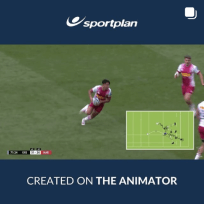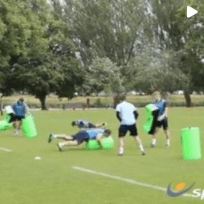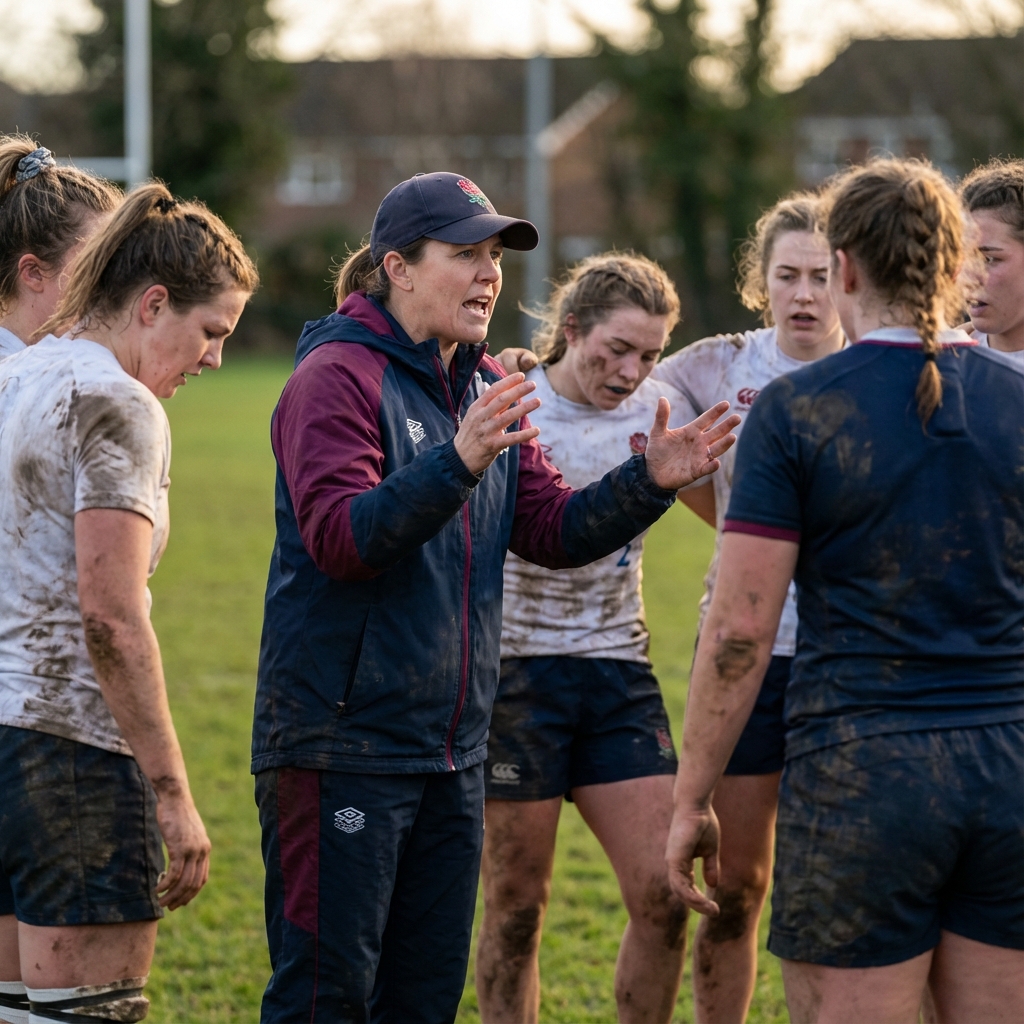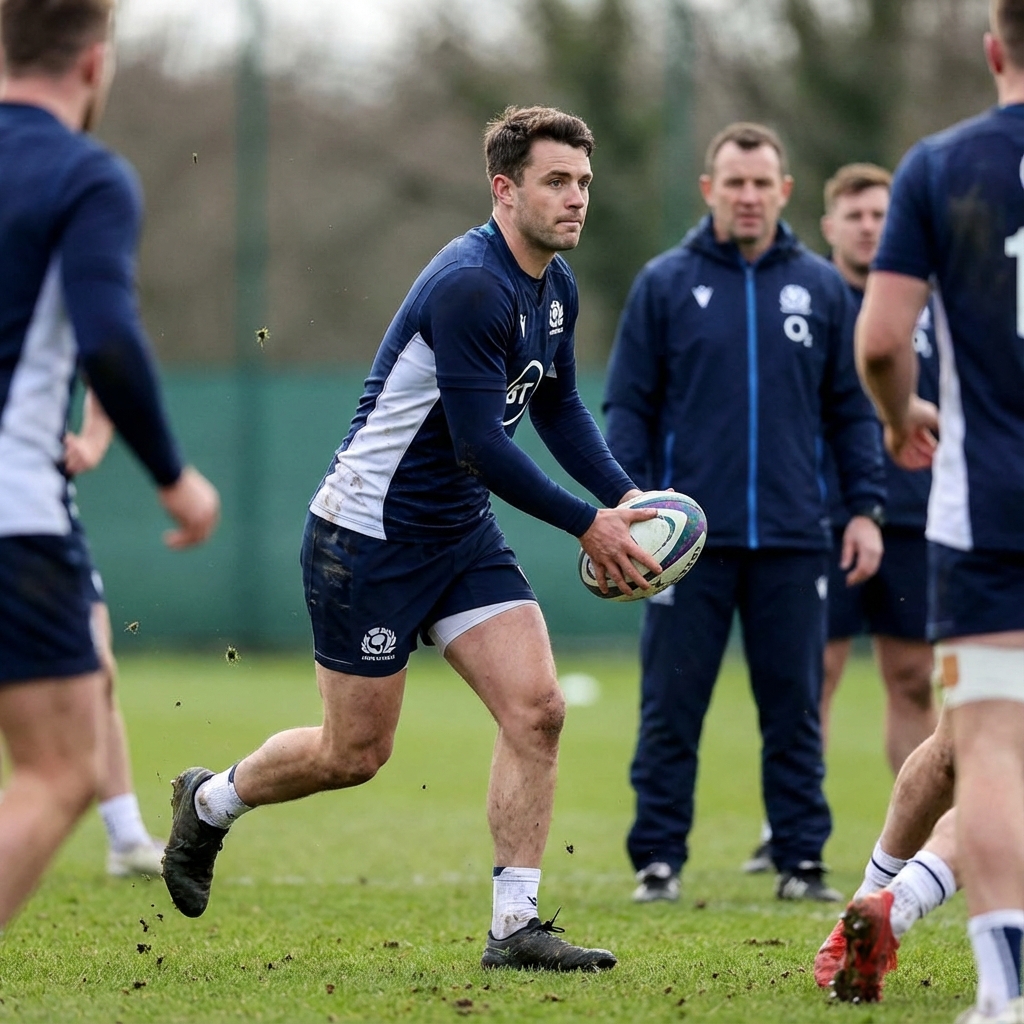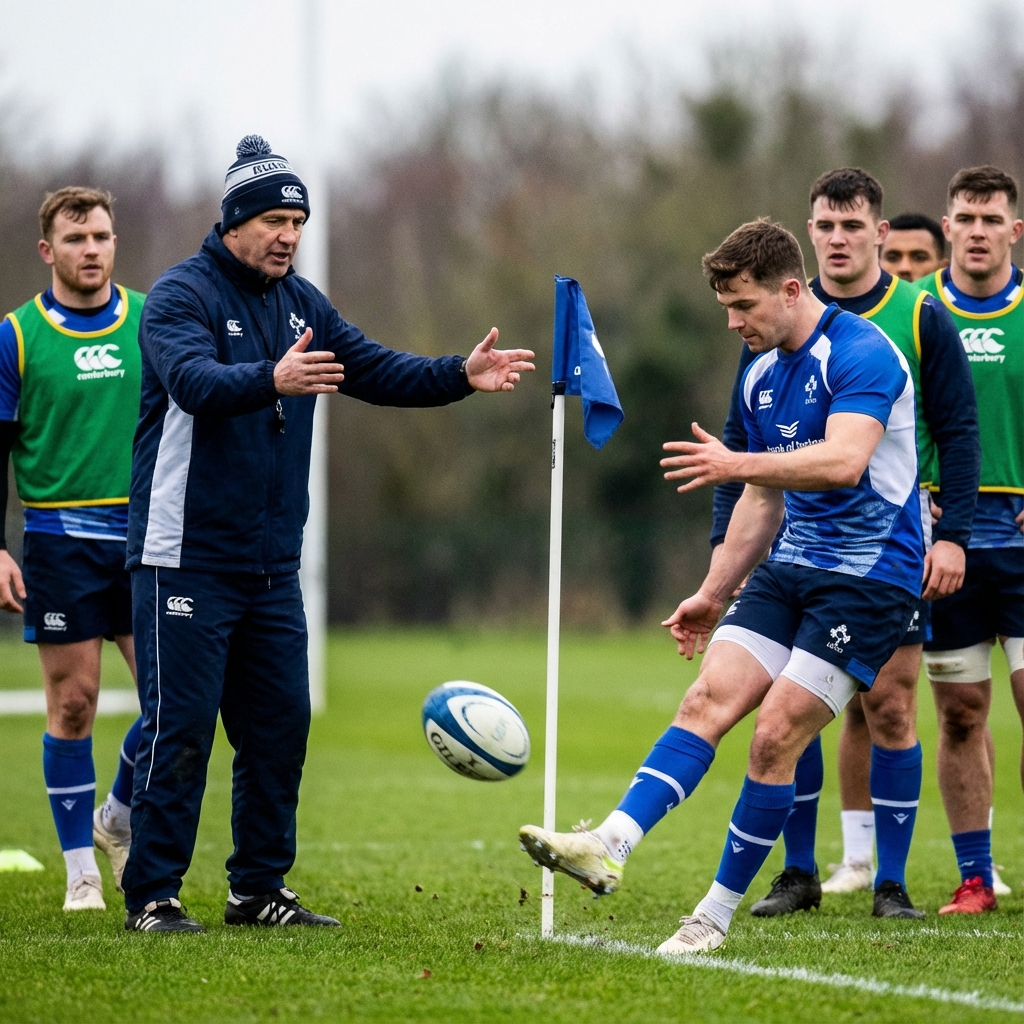U10s organisation in defence. How to improve?
I have started an under 10s team up, and I would say about 8 from the 13 children I have , did not play rugby until about 6 months ago. Of these players, there seems to be a lot of potential, as we are scoring tries against teams, that very rarely concede tries.the problem I got with them, is that we are very poor at organising our selves in defense when the opposition has the ball, which does result in us conceding quite a few tries. We have some very good tacklers in the team. Can anyone offer some ideas on how I can get them to organise themselves? Thanks . Chris.





This is for 10 aside U10s but can be altered as required.
I use an idea that I got from a coaching magazine. Assign the players roles in conjunction with their pitch positions; wingers always stay out of rucks and mauls, tacklers are the scrum and fly half who stay out also. Nutters are the ruckers and maulers - basically every one else.
Also, give the scrum half the role of deciding numbers in contact situations. He/she should be vocal. I found that by keeping the wingers always out then there was more depth in defence. They can also see what`s going on from the side of the pitch.
Hi Christopher,
We put this question out on our Facebook page to see what other coaches might have to say about it, and two coaches felt that at that age the most important thing is that they enjoy the game, and also said to make sure they keep attacking which will help them enjoy it.
One coach did say that if you insist on some sort of structure, then the best way to improve organisation in defence would be to ensure your players talk to each other and improve communication.
Hope this helps!
Your squad will get a lot of fun out of this drill:
Get your squad into two teams of six. Have one team as Attackers, the second as Defenders. Have the teams stand at each end of the pitch facing each other. Divide your pitch into three lanes of equal distance, pair your teams up and have them occupy the lane end at their end of the pitch.
- Each defending pair must work together and protect their lane, they are not allowed to enter the lane next to them they must stay within the lane. This should promote defensive head on tackling and 'ripping' the ball, it provide players with an understanding of the importance of creating and holding a defensive line.
- The attacking team is also split into pairs occupying a designated lane each. They are also not allowed to move out of their lane. Passing from lane to lane should be promoted by players calling for the pass.
- Promote the number of completed passes, if the ball is dropped during a pass then it should act as a turnover and the defenders get the ball.
You should find that the ball will actually get passed across the pitch from wing to wing and that the whole team on both sides do get very involved. It's good to stop the game when the defenders have held their positions the attackers failed to score and point out the value of holding their positions and working as a team.
One drill I do is rush defence with my U9's. I divide the pitch in 5 lanes, I put 5 players at each end of the pitch, each one in a lane. The attacking team start with ball in hand. I blow the whistle and the defendinteam has to rush towards attacker as one line, each player staying in his lane. The objectives is to stop the attacking team from breaking the half pitch line. This teaches my defence how to defend as one "wall", man to man, and push attackign team back. you can add the tackle if you want to work on one on one tackle.
thanks oliver and adi for your answers. i will give them a go. after reading back my original question, i realised that i should have perhaps put my question in a different way? all the kids seem to want to be involved around the breakdown area , and i wanted to try and find a way to limit numbers so that it does not leave the rest of the field as a wide open space. Thank you all for your answers.
In that case then, I think a little part of the practice around that issue should be a little chat with the players, to make sure that they understand the purpose of a breakdown and the goals when in defense and attack.
Once they validate the fact that it's not just about numbers, I would play a slow pace - regular tackle rugby game, but as a coach, I would work on the rules to have the team perform what I want:
- Same numbers on both teams, one team will only attack, the other one only defend. Then after some time, switch roles.
- At first, I's ask the defense - after each tackle - to commit 5/6 defenders in the ruck (no need to ruck, just get behind it and stay there). Attack has to wait for defense to be set that way before playing the ball. After few runs, have the team tell me what the problem is (not enough numbers in defense line...)
- Then I'll ask the defense the same thing, but with only 2/3 defenders in the ruck. Again give them time to set their line before playing the ball. Have the players tell me what the difference is.
Once both sides have gone through that game, the team would play a regular full on tackle game, but with a very specific rule: each time the defense commits more than 3 players in a ruck (including tackler), it must retreat 10 meters...
Hi the new rules we are playing with in Birmingham which I think become England wide in next season limits the ruck and maul to the ball carrier, tackler plus 1 from each side - this forces the kids to stay out and you can then encourage them to think about where they stand if they are not involved in the contact. If you are wanting to encourage a more disciplined defence with some line speed I have found it quite effective to get the players as a line to follow a ball held by the coach - they come up, go back, crab left, crab right etc. Then if you want to move things on try a chase the ball challenge - get a set of 5 players to form an attacking line (use cones if you like) and their goal is pass the ball through their hands as quickly as they can out to the wing. Pitted against them is a flat defence who have a simple challenge of coming up as a line and touching the player opposite before they have moved the ball (start with a straight line up - but you can move this on to one out or blitzing as they get more experienced). The defence each hold a coloured cone in their hand and must place it down where they reach when they come up - they can repeat with a different cone and try and improve their line speed and order as inevitably first time they don't beat the ball and/or have dog legs/holes. The kids like seeing the immediate and visual improvement and you work in a pressure handling drill in to boot - my u10s do this every couple of weeks for about 10 minutes as a warm up and they all seem capable of performing it with some success - hope that helps
Adi and Oliver, I love those drills. I'll definitely be giving them a go in the near future.
Christopher, it sounds to me that you have a very common problem among kids of this age, and one I've been dealing with a lot this year, kids not playing as a team. Younger kids seem to have a tough time understanding the dynamics of a team and just want to have the ball. In attack, that usually means never looking up and rarely passing, in defence it often means the whole team hanging around the ball and never setting up a defensive line.
We've started to overcome this by demonstrating to the kids what happens when you leave big gaps in the wall. We'll set up an offensive line across the pitch, while the defense all stands together on one side of the pitch. When the attacking team scores we'll ask why. The kids are usually able to tell us why, which is a beginning to having them line up defensively because they understand what happens if they don't.
Another think I like to do is to name one of the more experienced players as captain and have him organise the defence, rather than just having the coaches do it.
It takes time, patience and discussion.
Hope this helps
Darragh
Thanks for your answers guys. Much appreciated. Like I say, we have only been playing as a team since September, so we have got plenty of time. It does please me though that they enjoy the offloadind side of the game. I have had to encourage this as our breakdown side of the game usually comes off 2nd best. Thanks all.
Good point Daragh. Actually I have a captain leading from Front and a vice captain whose mission is to organise defence as a line (wall). I think the idea of corridors at drills forces them to stick to their line rather than gathering around the ball. But in games you have to force that to happen by commiting only 2 -3 players to ruck (we dont do rucks at U9's)...
We have just started working on this the last couple of sessions because at a recent tournament our kids we're great in offense: passing, teamwork, support etc, but poorly organised in defense.
We have 2 sessions a week, 1 hour wednesday and 2 on saturday mornings. Given the time constraints on wednesday we worked on tackling, so after basic tackling warmups and a short obstacle course I had the kids run laterally through an agility ladder then tackle a player with a tackle shield.
Saturday, we started with the warmups and obstacle course again, then had them run, as a team 5 - 10 metres at a time wih corridors marked out with cones. At first, the trainers gave the signal, then a player was designated to signal the charge.
Once they started working together, listening for the signal we split them into offence and defence.
We had the offensive team spread out with depth and tightened the defence on the side of the pitch where the ball was, as if gathered around a ruck. This forced them to choose their man and cover ground laterall/ diagonally in order to make their tackle.
In a short time, the defensive side started really working together, organising the defence as a single unit and driving the attackers backward.
We didn't allow the defence to play the ball, they were forced to tackle.
Hope this helps
Darragh
Thankyou Darragh, I will definitely give this a go. Hope fully we will be training outdoors again from next week. We have only played once since dec 2nd due to the weather. It will be like starting all over. Thanks.
Hey Christopher, I would suggest focusing on 2 things at this stage: Get the boys to have a pillar and post at every defensive breakdown and the rest must fan out in defence.
At this young age there's no point hampering their growth with rigid structure but the pillar/post system holds true for most defensive systems up to pro rugby so the sooner they learn the better.
A simple pillar/post or make it even easier by naming the pillar/post something else that is possibly humorous so it stays in the mind of the young ones.
Drill wise there's no point going into any set defensive drills at this young age I don't think, your primary defensive focus needs to be on tackle technique. It is vital that the kids are taught proper tackling technique from this early age.
Thankyou Ridaa. I totally agree with you on going into ant defensive set drill. I should have phrased my question differently. Since i asked the question the kids involved have done really well. We have not been able to train outdoors, due to the weather since about october. So, our tackling and rucking has had to take a back seat. But, this has helped us enormously in the attacking part of our game. The kids are offloading and passing really well, and although we are not winning many games, we are losing by small margins. This is considering they are missing tackles, losing out at rucks etc. I tell them how heartning that is, as i am sure, they will get better at this when we start training outdoors again. I am happy at the mo to see them running the legs off the ball. Would you mind explaining the pillar and post drill? Thankyou Ridaa.
Keep it simple. You want to teach them to "hold" a defensive line?You need a 20 - 30 metre rope.Get 2 adult helpers to hold either end of the rope across the field.Get the players to stand behind the rope along -side each other..one arms length apart. Also get them to hold on to the rope with both hands.The coach stands 10 metres away..facing them..he may hold a rugby ball for added effect!Coach moves towards the players and diagonally and team must mirror his diagonal movements.This little excercise teaches them to maintain a defensive line shape. Do this at every practice session in little doses until you eventually "wean" them off the rope.Have fun.
Answered using Sportplan on Mobile
Thanks for your answer Charles. I will try that out. I know they are only under 10s , but we are a new side , and when they are attacking they are scoring plenty of tries. We are beating teams even though organisationally we look a shambles on the field. I am just trying to give them gentle nudges in the right direction.
This is for 10 aside U10s but can be altered as required.
I use an idea that I got from a coaching magazine. Assign the players roles in conjunction with their pitch positions; wingers always stay out of rucks and mauls, tacklers are the scrum and fly half who stay out also. Nutters are the ruckers and maulers - basically every one else.
Also, give the scrum half the role of deciding numbers in contact situations. He/she should be vocal. I found that by keeping the wingers always out then there was more depth in defence. They can also see what`s going on from the side of the pitch.











